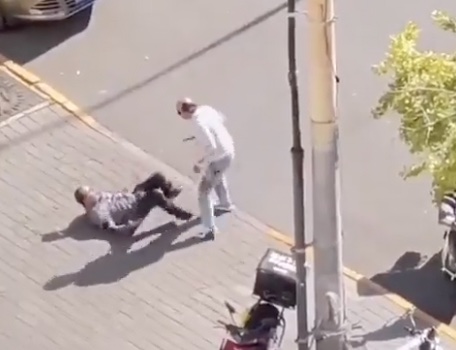‘White Faced Lies’: A graphic novel about a con man on the road in China
A road movie in book form, White Faced Lies tells the tale of a sketchy foreigner who lives in Beijing and his final attempt to wring the maximum benefit from his Western face.

Face job is slang for a job in which an aging Western expatriate man in China pretends to be a foreign businessman and attends corporate events to make a Chinese company seem more international or established.
This is the work done by Stan, the anti-hero of White Faced Lies, a just-released graphic novel by Eric Flanagan and Sam Voutas, illustrated by Timothy McEvenue. Stan is an American living in Beijing around 2010, making his living as a “face-jobber.” He cons a young man, who believes Stan to be his father, into tagging along with him on a road trip around China for a series of “face jobs.”
All three of the creators of White Faced Lies have lived in Beijing and other parts of China, and you can tell by the authenticity of the illustrations and some of the story details. The cheap candelabras and air filters that characterized many Beijing apartments about a decade ago, the storefront signs, the concrete bollards lining country roads, and some of the situations the characters find themselves in will be recognizable to anyone who spent time in China in the first decade and a half of the 21st century.
Sam Voutas is Australian but grew up in Beijing in the 1980s and ’90s and went on to make several films in that city, including the Chinese-language feature Red Light Revolution (2010) and King of Peking (2017). Originally from Texas, Eric Flanagan began his career in the New York television industry. His short film Teleglobal Dreamin, about a call center agent in Manila, won a jury award at the 2010 South by Southwest, and was sold to the Sundance Channel and PBS.
Eric and Sam answered some questions from The China Project about their new work:

When and where did the idea for the book come from? Why did you choose “face jobbing” as the key feature of the story?
SV: The idea started in late 2009, when I was living in Beijing. I knew a few Americans in town who were doing face jobs. And of course the work is just so peculiar and specific to China. When you first hear about it, you can’t quite believe that a job like that actually exists.
I was reading a lot of Hunter S. Thompson at the time, Hell’s Angels, that type of thing, and quite naively thought I’d give that type of gonzo research a go. I thought a book might come out of it, or a movie, I wasn’t sure. So I bought an MP3 recorder and arranged to be introduced to a face job agent.
Before long, I was traveling around China pretending to be various American or British businessmen. And on each of these trips I was hiding this little recorder in my suit. It was a stupid thing to do. I soon realized I just wasn’t cut out for this style of gonzo writing. It was too risky, and just not worth it for the quality of material I was getting. So I stopped and put the whole project on hold.
White Faced Lies feels like a road movie in graphic novel form. Did you ever plan to make it into a film, or was that never going to be possible? Or are you still planning to make a film?
EF: The story was originally written as a script intended to be made as an indie feature film, with Sundance even getting involved at one point. But things were shifting a lot at the time in terms of the film industry, and keep in mind this was before Netflix exploded as a streamer.
Sam and I also looked at the diminishing openness of China as a viable shooting location, so we opted to go the graphic novel route. And now that the story exists as IP, there’s still the possibility it could become a film, since there are now many ways to make a movie about a specific place without needing to be there physically.
How did you begin collaborating on White Faced Lies?
EF: Sam and I met back in 2005 in Beijing, where we were both working on various documentary and film projects. Years later, in 2010 while I was based in Singapore, I came across an online article about face jobs in China and thought it would be great material to build a story around. So I sent it to Sam, who was still living in Beijing, and learned he not only knew about face jobs but was already doing actual face jobs as research for a possible book.
SV: Yeah, when Eric called me, I was quite depressed that my face job research hadn’t amounted to anything. I had the recordings, and various specifics from that world, but that’s about it. So when Eric said he was keen to do a story about the world of face jobs, too, I was elated. Eric and I would often circle the same story topics, particularly ones involving fakery, and we’d been talking for years that we should team up on something. And that was the beginning of our collaboration.

How did you find Timothy McEvenue to illustrate it?
SV: Once we decided to make the story a graphic novel, Eric and I began searching for an illustrator to join the team. We knew we had to find someone with a very particular eye, someone who’d lived that type of China experience.
A good friend in Beijing mentioned Tim, and I remembered that I’d once worked with him during the Olympic Games in 2008. So I met up with Tim in Sanlitun, and Eric and I immediately knew we’d found our illustrator. Tim had lived in China for so many years, and it really shows in his work. His pictures are just so full of tiny details that he’s remembered from various experiences he’s had. Tim had worked as a model in China as well, which proved invaluable for understanding where we were coming from storywise. So in many ways, we couldn’t have found a more perfect illustrator for the project.
When is the story set?
SV: We set it in 2010, which we felt was the heyday of the face job industry in China. Sort of the last big hurrah for guys in that profession. Of course, face jobs continued on well after that, but 2010 was the romance period, face jobs were hopping. If you were white, American, had graying hair, there was that world open to you. And those guys doing those face jobs, many thought it would last forever. Basically, as U.S.-China relations went cold, so did the market for having a random smiling Westerner turn up for photo ops.
What are the themes you wanted to address in the story?
EF: The book’s story had many different drafts and iterations over the years, but what always remained a constant was the interplay between “real” versus “fake,” and the value of a fake thing that is accepted as real.
SV: And also just to explore the idea of giving face. A so-called good face can often be merely a facade. If you scratch just a little, you find another thing altogether.






